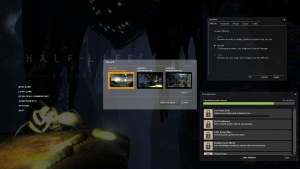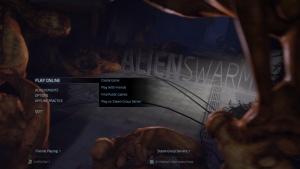GameUI
- Not to be confused with the game_ui entity.
GameUI is the code which provides the VGUI 'frontend': broadly speaking, the main menu and loading screens.
GameUI panels are children of their own dedicated panel ("GameUI Panel"). The client's RootPanel is used only for in-game HUD elements.
Source 2004 to Source 2013

In the original branches of Source (from Source 2004 to Source 2013), GameUI is a closed engine library manipulable to a limited extent by editing .res script files. These define properties like width, height, element location, and so on. You can add new non-interactive elements and with a bit of effort hide existing ones.
It is possible to create new VGUI panels that behave in exactly the same way as GameUI ones. Starting with Source 2013 (which uses elements from Team Fortress 2), such panels can override the default main menu with four new functions included in IGameUI.
It's worth noting that this version of GameUI still exists internally in every Source game made by Valve, though to what extent it is accessible or functional varies by game. Newer games (starting with Left 4 Dead engine branch) typically only use it for the console and server browser. Counter-Strike: Global Offensive since newer updates have removed nearly all commands (except openserverbrowser) to show the original GameUI.
Left 4 Dead to Alien Swarm engine branch
The Alien Swarm SDK contains the complete source for the newer L4D-style GameUI (also referred as L4D360UI in game files), which has been moved into the client library. It has been redesigned for consoles' lack of a pointing device: everything is integrated into the same navigable menu system, and you can't be in more than area at once. It's also far, far easier to program.
Creating a new window
- Create a new class, inheriting from
CBaseModFrame. - Create an accompanying "<class name>.res" script in
game\resource\ui\basemodui\. - Add a new entry to the
WINDOW_TYPEenum. - Edit the enormous switch in
CBaseModPanel::OpenWindow()to include your new enum and class.
The ugly enum/switch indirection is presumably designed to allow a single "window type" value to open slightly different window objects depending on the UI's state. Too bad Valve haven't found any excuse to do that yet!
Opening windows
Use CBaseModFrame* CBaseModPanel::OpenWindow():
#include "gameui\swarm\basemodpanel.h"
using namespace BaseModUI;
void openwindow()
{
CBaseModFrame* mainMenu = CBaseModPanel::GetSingleton().GetWindow( WT_MAINMENU );
CBaseModPanel::GetSingleton().OpenWindow( WT_GAMESETTINGS, mainMenu );
}
The arguments are:
WINDOW_TYPE &wt- An enum value that defines which precise window to open.
CBaseModFrame* caller- The window which requested this one to open. Among other things, this becomes the target of 'back' buttons on the new window.
bool hidePrevious- Hides
callerif true. KeyValues* pParameters- Passed on to the new window.
OnOpen() is called on the opened window.
Startup
The initialization sequence is:
CGameUI::Initialize()CBaseModPanel::RunFrame()CBaseModPanel::OnGameUIActivated()CBaseModPanel::OpenFrontScreen()CBaseModPanel::OpenWindow()
CBaseModPanel is a singleton; CBaseModFrame is the base class of all windows.
